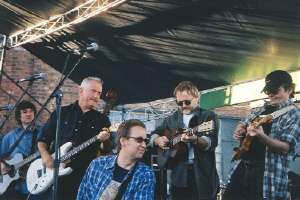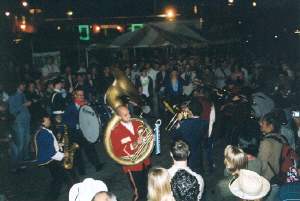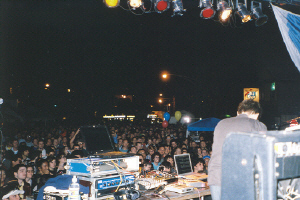
Co-owner Tim Tuten of the Hideout (Photo By: Chris Castaneda)
It's interesting how bars and clubs become these grand institutions within a music community. To the neighbors of such places, they can sometimes be thought of as eye sores. For those patrons who earn the distinguished rank of the "regular," they are shrines; home away from home, special haunts where their favorite beer is served or music can be frequently heard. One such local Chicago filling station is the Hideout.
Growing up on the South Side of Chicago, there weren't many options as a 13-year-old to hang out and hear live music. At that time I was still a mallrat with my ragtag group of friends, walking the streets of Calumet City believing the same purpose we all shared in our heads: that we were going to have boundless fun, that our Friday night was going to mean something. I longed for the day I could venture out more often to venues like Lounge Ax, Metro, and Schubas. They were these mythic establishments that I would only hear about on the radio or read about in the newspapers.
Going to DePaul and being surrounded by Lincoln Park was like launching into space and landing on Jupiter. Suddenly I was in arms reach of the music that always vibrated everywhere else but where I lived. I never really felt the restraints of my pre-21 years. I had my choices of all ages or 18 and over concerts, and I still worked my dream job at a record store in Calumet City called Hegewisch Records. Life was fine. I never owned a fake ID. I didn't feel that rush to exceed my age. But a concert here and there would cause a knee jerk reaction. In 2000, I actually considered growing a beard just to see if I could gain access to a 21 and over show by Jeff Tweedy of Wilco at Park West. That was probably the only time I ever felt desperate about not being 21.

Pine Valley Cosmonauts 9/26/2004 (Photo By: Chris Castaneda)
After December 1, 2001, I was official and the city was open to me. My very close friend, a compatriot from my grammar school and high school days, turned 21 days after me on New Year's Eve. Our major night out as 21-year-olds was to this bar he heard often about in the Chicago Reader. We got directions and ventured off into the night. As we exited onto North Ave. off the Kennedy Expressway, we both reacted to the industrail flavor of the neighborhood. By industrial, I'm not talking Gothic children of the night wandering about and rows of leather bars pumping out Joy Division. We essentially travelled from one dilapidated steel mill neighborhood to another. As he slowly drove us past the Hideout, we both looked at each other and said, "This is it?"
Almost with a deep breath, we took those steps towards the bar probably wondering what we just got ourselves into. The building looked like something from another era but with an Old Style sign hanging over the door. It all evoked this sensation you might have when visiting the grandparents on Thanksgiving or some holiday.

Bobby Bare Jr. 9/26/2004 (Photo By: Chris Castaneda)
But something happened as we walked into the bar. Maybe it was the Christmas lights that hung from the ceiling and around the bar. Or maybe it was the balance of chatter and music that just felt right. It had that blue collar charm of home but it wasn't our home. My friend and I turned and smiled at each other, giving a nod in agreement as if saying, "Ok, this ain't bad." We had chosen our escape.
Fast forward to November of 2002 when I had just seen the Swedish sensation known as the Soundtrack of Our Lives at Metro. Afterwards, I was able to meet three of the six members: Ebbot Lundberg, Ian Person, and Mattias Barjed. My interview with the band's lead singer, Lundberg, had just come out in The DePaulia days before the show. So, it was an obvious thrill to meet the tunic wearing, Shaman-esque singer. While chatting with Person about how the band's tour supporting Oasis went, he invited me to tagalong to the Gingerman Tavern, next door to Metro.
As I entered, I noticed someone sitting at one of the tables in the bar. It happened to be Tim Tutuen, co-owner of the Hideout. In a September article in The DePaulia, I was asked to do a Top-5 Clubs list as a sidebar to an article I had done about the overlooked local band called Verbow. Ranked #2 on my list of local clubs was the Hideout. When the article was published I e-mailed Tuten to let him know that our newspaper mentioned the club. Still very fresh in my rock critic shoes, I didn't expect much of a response back over a college newspaper writing a small blurb about a club, but I got one. Tuten wrote probably one of the nicest responses I had ever gotten from anyone who read my work. I still have it saved in my inbox of my e-mail.

Mocca Pazza Red Moon Marching Band 9/25/2004 (Photo By: Chris Castaneda)
Tuten and I would bump into each other now and then, usually at the Hideout or while in the company of Greg Kot (Chicago Tribune) and Jim DeRogatis (Chicago Sun-Times), my rock critic Zen masters who befriended me early on in my journalistic adventures.
It wasn't until the Hideout's 8th annual Block Party in the fall of 2004 that I truly understood what makes the Hideout the unique club that it is. This wouldn't be the first time I attended the Block Party. I talked my original Hideout companion to come with me to check out Guided By Voices headline a day. For the recent incarnation of the fest, Tuten granted me the best VIP press pass that I don't think will ever be beaten. Being a fellow fan of Paul Weller and The Jam, Tuten had some fun with the pass, which was just an e-mail with big bold letters. I plan on getting it framed one day:
HIDEOUT BLOCK PARTY
2004
VIP PRESS PASS FOR
CHRIS
ALL-ACCESS
ALL DAYS
ALL THE MOD CONS

Marah 9/24/2004 (Photo By: Chris Castaneda)
During the course of September 24-26, the Hideout Block Party drew between 4,500-5,000 attendees. "I slept fifteen hours in three days," said Katie Tuten, wife to Tim and also co-owner of the Hideout. Next to the tasty variety of the twenty-nine band lineup were the notable not-for-profit organizations that received a kind, lending hand from the club. The $14,238.58 raised by the Hideout during the three day fest went towards the charities of CAUSES/Play, Literacy Works, and Tuesday's Child.
Each day I was there had a different vibe. Roaming around behind the main stage I could see there was a real communal sense among the bands and people involved with the fest. The genres of music mixed together on one bill was astounding. For the headliners of the second night, Mouse on Mars, Tim had to clarify to the German group, undertaking their first tour of North America, that the Block Party wasn't some Midwestern ho-down surrounded by cows and barns. On the third day, Bloodshot Records, one of the most venerated Chicago labels, was honored for its tenth anniversary by being given the last day of the Block Party to showcase some of the labels fine acts such as Split Lip Rayfield, the Pine Valley Cosmonauts, and Bobby Bare Jr.

Strong Numbers For Mouse On Mars 9/25/2004 (Photo By: Chris Castaneda)
"It is a lot of work, but we always have a good time," said Katie Tuten. They most certainly do.

Drummer Dodo Nkishi & Jan St. Werner of Mouse On Mars (Photo By: Chris Castaneda)
On the outside, the Hideout looks like your average bar with that slight touch of "dive bar" aura surrounding it, but it's the people inside that make it more than ordinary. It's all about the intangibles when it comes to making a bar or a club extraordinary. There's a reason why five years later people still talk about Lounge Ax as if it were a Chicago legend. We talk about these buildings made of brick as if they were family members, both with their good and bad qualities. Deep down we still love them.
Tim and Katie Tuten and everyone associated with the Hideout have good reason to be proud of their little shack on W. Wabansia St. They are a reminder that heart and soul will always outlive flash and gloss.
No comments:
Post a Comment